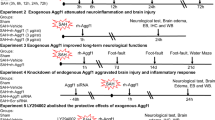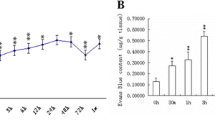Abstract
Blood–brain barrier preservation plays an important role in attenuating vasogenic brain edema after subarachnoid hemorrhage (SAH). This study was designed to investigate the protective effect and mechanism of artesunate, a traditional anti-malaria drug, on blood–brain barrier after SAH. Three hundred and seventy-seven (377) male Sprague–Dawley rats were subjected to endovascular perforation model for SAH. The rats received artesunate alone or in combination with Sphingosine-1-phosphate receptor-1 (S1P1) small interfering RNA (siRNA), antagonist VPC23019, or phosphatidylinositol 3-kinase inhibitor wortmannin after SAH. Modified Garcia score, SAH grades, brain water content, Evans blue leakage, transmission electron microscope, immunohistochemistry staining, Western blot, and cultured endothelial cells were used to investigate the optimum concentration and the therapeutic mechanism of artesunate. We found that artesunate (200 mg/kg) could do better in raising modified Garcia score, reducing brain water content and Evans blue leakage than other groups after SAH. Moreover, artesunate elevated S1P1 expression, enhanced phosphatidylinositol 3-kinase activation, lowered GSK-3β activation, stabilized β-catenin, and improved the expression of Claudin-3 and Claudin-5 after SAH in rats. These effects were eliminated by S1P1 siRNA, VPC23019, and wortmannin. This study revealed that artesunate could preserve blood–brain barrier integrity and improve neurological outcome after SAH, possibly through activating S1P1, enhancing phosphatidylinositol 3-kinase activation, stabilizing β-catenin via GSK-3β inhibition, and then effectively raising the expression of Claudin-3 and Claudin-5. Therefore, artesunate may be favorable for the blood–brain barrier (BBB) protection after SAH and become a potential candidate for the treatment of SAH patients.









Similar content being viewed by others
References
Feigin VL, Lawes CM, Bennett DA, Anderson CS (2003) Stroke epidemiology: a review of population-based studies of incidence, prevalence, and case-fatality in the late 20th century. Lancet Neurol 2(1):43–53
Zhang JH, Badaut J, Tang J, Obenaus A, Hartman R, Pearce WJ (2012) The vascular neural network—a new paradigm in stroke pathophysiology. Nat Rev Neurol 8(12):711–716. doi:10.1038/nrneurol.2012.210
Chen S, Feng H, Sherchan P, Klebe D, Zhao G, Sun X, Zhang J, Tang J et al (2013) Controversies and evolving new mechanisms in subarachnoid hemorrhage. Prog Neurobiol. doi:10.1016/j.pneurobio.2013.09.002
Mirshafiey A, Saadat F, Attar M, Di Paola R, Sedaghat R, Cuzzocrea S (2006) Design of a new line in treatment of experimental rheumatoid arthritis by artesunate. Immunopharmacol Immunotoxicol 28(3):397–410. doi:10.1080/08923970600927447
Kaptein SJ, Efferth T, Leis M, Rechter S, Auerochs S, Kalmer M, Bruggeman CA, Vink C et al (2006) The anti-malaria drug artesunate inhibits replication of cytomegalovirus in vitro and in vivo. Antivir Res 69(2):60–69. doi:10.1016/j.antiviral.2005.10.003
Chen H, Shi L, Yang X, Li S, Guo X, Pan L (2010) Artesunate inhibiting angiogenesis induced by human myeloma RPMI8226 cells. Int J Hematol 92(4):587–597. doi:10.1007/s12185-010-0697-3
Efferth T, Dunstan H, Sauerbrey A, Miyachi H, Chitambar CR (2001) The anti-malarial artesunate is also active against cancer. Int J Oncol 18(4):767–773
Souza MC, Paixao FH, Ferraris FK, Ribeiro I, Henriques M (2012) Artesunate exerts a direct effect on endothelial cell activation and NF-kappaB translocation in a mechanism independent of plasmodium killing. Malar Res Treat 2012:679090. doi:10.1155/2012/679090
Zhou Y, Lekic T, Fathali N, Ostrowski RP, Martin RD, Tang J, Zhang JH (2010) Isoflurane posttreatment reduces neonatal hypoxic-ischemic brain injury in rats by the sphingosine-1-phosphate/phosphatidylinositol-3-kinase/Akt pathway. Stroke 41(7):1521–1527. doi:10.1161/strokeaha.110.583757
Hasegawa Y, Suzuki H, Sozen T, Rolland W, Zhang JH (2010) Activation of sphingosine 1-phosphate receptor-1 by FTY720 is neuroprotective after ischemic stroke in rats. Stroke 41(2):368–374. doi:10.1161/strokeaha.109.568899
Altay O, Hasegawa Y, Sherchan P, Suzuki H, Khatibi NH, Tang J, Zhang JH (2012) Isoflurane delays the development of early brain injury after subarachnoid hemorrhage through sphingosine-related pathway activation in mice. Crit Care Med 40(6):1908–1913. doi:10.1097/CCM.0b013e3182474bc1
Rolland WB 2nd, Manaenko A, Lekic T, Hasegawa Y, Ostrowski R, Tang J, Zhang JH (2011) FTY720 is neuroprotective and improves functional outcomes after intracerebral hemorrhage in mice. Acta Neurochir Suppl 111:213–217. doi:10.1007/978-3-7091-0693-8_36
Zhang J, Honbo N, Goetzl EJ, Chatterjee K, Karliner JS, Gray MO (2007) Signals from type 1 sphingosine 1-phosphate receptors enhance adult mouse cardiac myocyte survival during hypoxia. Am J Physiol Heart Circ Physiol 293(5):H3150–H3158. doi:10.1152/ajpheart.00587.2006
Krafft PR, Caner B, Klebe D, Rolland WB, Tang J, Zhang JH (2013) PHA-543613 preserves blood–brain barrier integrity after intracerebral hemorrhage in mice. Stroke 44(6):1743–1747. doi:10.1161/STROKEAHA.111.000427
Finney CA, Hawkes CA, Kain DC, Dhabangi A, Musoke C, Cserti-Gazdewich C, Oravecz T, Liles WC et al (2011) S1P is associated with protection in human and experimental cerebral malaria. Mol Med 17(7–8):717–725. doi:10.2119/molmed.2010.00214
Li B, Luo C, Tang W, Chen Z, Li Q, Hu B, Lin J, Zhu G et al (2012) Role of HCN channels in neuronal hyperexcitability after subarachnoid hemorrhage in rats. J Neurosci 32(9):3164–3175. doi:10.1523/jneurosci.5143-11.2012
Suzuki H, Hasegawa Y, Chen W, Kanamaru K, Zhang JH (2010) Recombinant osteopontin in cerebral vasospasm after subarachnoid hemorrhage. Ann Neurol 68(5):650–660. doi:10.1002/ana.22102
Garcia JH, Wagner S, Liu KF, Hu XJ (1995) Neurological deficit and extent of neuronal necrosis attributable to middle cerebral artery occlusion in rats. Statistical validation. Stroke 26(4):627–634, discussion 635
Sugawara T, Ayer R, Jadhav V, Zhang JH (2008) A new grading system evaluating bleeding scale in filament perforation subarachnoid hemorrhage rat model. J Neurosci Methods 167(2):327–334. doi:10.1016/j.jneumeth.2007.08.004
Suzuki H, Hasegawa Y, Kanamaru K, Zhang JH (2010) Mechanisms of osteopontin-induced stabilization of blood–brain barrier disruption after subarachnoid hemorrhage in rats. Stroke 41(8):1783–1790. doi:10.1161/STROKEAHA.110.586537
Chen Y, Zhang Y, Tang J, Liu F, Hu Q, Luo C, Tang J, Feng H et al (2015) Norrin protected blood–brain barrier via frizzled-4/beta-catenin pathway after subarachnoid hemorrhage in rats. Stroke 46(2):529–536. doi:10.1161/strokeaha.114.007265
Yang F, Wang Z, Zhang JH, Tang J, Liu X, Tan L, Huang QY, Feng H (2015) Receptor for advanced glycation end-product antagonist reduces blood–brain barrier damage after intracerebral hemorrhage. Stroke 46(5):1328–1336. doi:10.1161/STROKEAHA.114.008336
Hu SL, Huang YX, Hu R, Li F, Feng H (2014) Osteopontin mediates hyperbaric oxygen preconditioning-induced neuroprotection against ischemic stroke. Mol Neurobiol. doi:10.1007/s12035-014-8859-6
Yusof W, Hua GS (2012) Gene, ethnic and gender influences predisposition of adverse drug reactions to artesunate among Malaysians. Toxicol Mech Methods 22(3):184–192. doi:10.3109/15376516.2011.623331
Zhao F, Wang H, Kunda P, Chen X, Liu QL, Liu T (2013) Artesunate exerts specific cytotoxicity in retinoblastoma cells via CD71. Oncol Rep 30(3):1473–1482. doi:10.3892/or.2013.2574
Marijon A, Bonnot G, Fourier A, Bringer C, Lavoignat A, Gagnieu MC, Bienvenu AL, Picot S (2014) Efficacy of intranasal administration of artesunate in experimental cerebral malaria. Malar J 13:501. doi:10.1186/1475-2875-13-501
Gautam A, Ahmed T, Batra V, Paliwal J (2009) Pharmacokinetics and pharmacodynamics of endoperoxide antimalarials. Curr Drug Metab 10(3):289–306
Wu D, Cerutti C, Lopez-Ramirez MA, Pryce G, King-Robson J, Simpson JE, van der Pol SM, Hirst MC et al (2014) Brain endothelial miR-146a negatively modulates T-cell adhesion through repressing multiple targets to inhibit NF-kappaB activation. J Cereb Blood Flow Metab. doi:10.1038/jcbfm.2014.207
Caner B, Hou J, Altay O, Fuj M 2nd, Zhang JH (2012) Transition of research focus from vasospasm to early brain injury after subarachnoid hemorrhage. J Neurochem 123(Suppl 2):12–21. doi:10.1111/j.1471-4159.2012.07939.x
Mendelson K, Evans T, Hla T (2014) Sphingosine 1-phosphate signalling. Development 141(1):5–9. doi:10.1242/dev.094805
Cyster JG, Schwab SR (2012) Sphingosine-1-phosphate and lymphocyte egress from lymphoid organs. Annu Rev Immunol 30:69–94. doi:10.1146/annurev-immunol-020711-075011
O’Sullivan C, Dev KK (2013) The structure and function of the S1P1 receptor. Trends Pharmacol Sci 34(7):401–412. doi:10.1016/j.tips.2013.05.002
Safarian F, Khallaghi B, Ahmadiani A, Dargahi L (2014) Activation of S1P receptor regulates PI3K/Akt/FoxO3a pathway in response to oxidative stress in PC12 cells. J Mol Neurosci. doi:10.1007/s12031-014-0478-1
Arya D, Chang S, DiMuzio P, Carpenter J, Tulenko TN (2014) Sphingosine-1-phosphate promotes the differentiation of adipose-derived stem cells into endothelial nitric oxide synthase (eNOS) expressing endothelial-like cells. J Biomed Sci 21:55. doi:10.1186/1423-0127-21-55
Taddei A, Giampietro C, Conti A, Orsenigo F, Breviario F, Pirazzoli V, Potente M, Daly C et al (2008) Endothelial adherens junctions control tight junctions by VE-cadherin-mediated upregulation of claudin-5. Nat Cell Biol 10(8):923–934. doi:10.1038/ncb1752
Gunzel D, Yu AS (2013) Claudins and the modulation of tight junction permeability. Physiol Rev 93(2):525–569. doi:10.1152/physrev.00019.2012
Cheng C, Ho WE, Goh FY, Guan SP, Kong LR, Lai WQ, Leung BP, Wong WS (2011) Anti-malarial drug artesunate attenuates experimental allergic asthma via inhibition of the phosphoinositide 3-kinase/Akt pathway. PLoS One 6(6), e20932. doi:10.1371/journal.pone.0020932
Thanaketpaisarn O, Waiwut P, Sakurai H, Saiki I (2011) Artesunate enhances TRAIL-induced apoptosis in human cervical carcinoma cells through inhibition of the NF-kappaB and PI3K/Akt signaling pathways. Int J Oncol 39(1):279–285. doi:10.3892/ijo.2011.1017
Author information
Authors and Affiliations
Corresponding authors
Ethics declarations
Conflict of Interest
The authors declared that they have no competing interests.
Source of Funding
This study was funded by National Natural Science Foundation of China (No. 81501002 to Yujie Chen, No. 81220108009 to Hua Feng) and the National Basic Research Program of China (973 Program, No. 2014CB541600 to Hua Feng).
Rights and permissions
About this article
Cite this article
Zuo, S., Ge, H., Li, Q. et al. Artesunate Protected Blood–Brain Barrier via Sphingosine 1 Phosphate Receptor 1/Phosphatidylinositol 3 Kinase Pathway After Subarachnoid Hemorrhage in Rats. Mol Neurobiol 54, 1213–1228 (2017). https://doi.org/10.1007/s12035-016-9732-6
Received:
Accepted:
Published:
Issue Date:
DOI: https://doi.org/10.1007/s12035-016-9732-6




